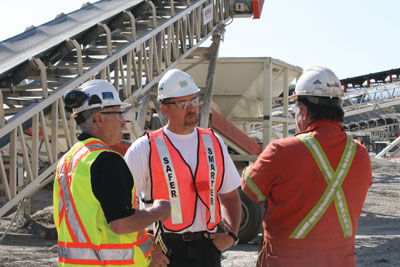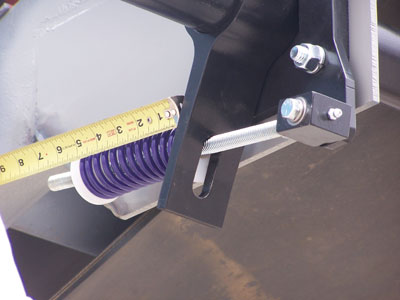
Features
Aggregates
Technology
Belt Conveyor Audits
Learn how to improve production, safety and equipment longevity.
April 17, 2012 By Chip Winiarski
Unexpected periods of downtime at an aggregates plant can lead to some major problems
Unexpected periods of downtime at an aggregates plant can lead to some major problems, including the inability to accommodate customer demands, worker downtime, overtime pay when plant employees return to work to fulfil those demands, and even safety issues as a plant struggles to get back up to speed. All too often, plant operators don’t even realize there’s a problem until production is halted. In the end, it all affects the operation’s bottom line.
 |
|
| The point of an audit is not simply to identify problems, but also to identify the root cause of those problems.
|
Why don’t more plants audit their equipment to detect potential problems before issues lead to costly repairs and downtime? Bringing in a third party who can assess your belt conveyor system and provide you with the feedback you need to keep the plant running could be the difference between having a record-breaking year and having a back-breaking year.
Why you should audit your system
There are many reasons to have someone come in and perform an audit on your operation. A fresh set of eyes looking at your system from an outside vantage point is important, especially since resources have been reduced at many operations and worker safety is still a major concern. Plus, the number of violations a plant can accumulate after a visit from an inspector can often result in unexpected downtime – another reason regularly scheduled audits are so important.
 |
|
| If your fasteners and belt cleaners aren’t compatible or your system isn’t centre loading, you could have a serious problem.
|
“Owners and operators who are around the conveyors every day may not notice the slight changes in the system, while a fresh set of eyes can identify issues,” says Rich Gilman, global service program manager for Flexco. “Instead of waiting for something to go wrong, they can help you address the issues proactively, saving time and money in unscheduled downtime.”
Gilman notes that safety issues are also a major concern when it comes to audits. Although the safety of workers is most important, the number of violations a plant can accumulate after a visit from an inspector is also important.
If nothing else, an audit can help keep your equipment running longer. Simple maintenance tasks that may have gone
unnoticed can be identified and addressed by your team, or components can be replaced that will make your equipment run more efficiently.
The formula for a good audit
Although each operation is different, the elements of a good belt conveyor audit are the same. And the No. 1 rule of thumb is to look at the conveyor system holistically.
“While each product in a conveyor system is a separate component, the entire system should be evaluated as a whole to ensure that everything is compatible,” Gilman said. “For example, if your fasteners and belt cleaners aren’t compatible or your system isn’t centre loading, you could have a serious problem.”
Focusing on system solutions, as opposed to simply focusing on replacing specific products, is also key to a good conveyor audit. Whoever walks the belt conveyor line needs to identify all of the issues they find, not simply the issues that they can fix with a product or service.
“We find plenty of problems that we don’t specifically have a fix for, but we still bring them to the attention of the operator and recommend that they seek expert help,” Gilman said. “If it looks like there may be a structural problem, we will show them what we have identified and suggest contacting an architect or engineer for advice.”
The point of an audit is not simply to identify problems, but also to identify the root cause of those problems. Simply telling an operation that the belt is dirty and suggesting a product to “fix” the problem is not a best practice when it comes to audits. An auditor should tell you why it is happening and why the solution he/she is suggesting will work for you.
Get the facts from your audit
As part of the audit plan, the auditor should visit the operation and evaluate the entire belt conveyor system. These specialists should be knowledgeable experts with strong technical skills and years of hands-on training with belt conveyor systems and components.
An auditor should identify the problems that pose immediate risks to the crew or equipment. The auditor should also record his/her findings and return to the operation with a complete presentation on the system, identifying immediate needs, and suggesting future fixes.
Look for an auditor that provides you with a complete report on the findings, identifying the issues and the importance of fixing each issue. Look for an auditor who will point out which fixes are immediate and which fixes are recommended for the future so that you can develop a timeline for these adjustments.
The top three audit findings
While damaged components and safety issues are always big concerns, the top three issues identified in a belt conveyor audit are carryback, spillage and mistracking. These issues may seem like simple things that should be noticed by your crew, but this isn’t always the case, according to Gilman.
 |
|
| A good rule of thumb is to inspect all of your conveyor system components as part of an overall maintenance plan.
|
“You and your crew look at your conveyors every day and the big issues may grab your attention; plant operators often get used to the rest of the everyday issues,” Gilman said. “You may think that a pile of debris sitting under your conveyor is common, when the reality is that the right adjustment or equipment could drastically decrease or eliminate that problem.”
Gilman notes that in a recent case, a plant in Toronto had developed a whole system to clean up its carryback. The plant supervisor felt it was efficient and limited downtime, and the plan accomplished that. However, after seeing a new Flexco cleaner installed by a Flexco specialist, the plant superintendent realized that all of their other cleaners were mounted incorrectly.
Proper installation of the cleaner resulted in an 80 per cent decrease in carryback. In this case, a belt conveyor audit could have identified the carryback issue and the incorrectly mounted cleaners for prompt corrective action.
Over time, carryback, spillage and mistracking can cause serious problems for your belt conveyor system. Although these may seem to be everyday issues, solutions are available and are integral to your operation’s success.
The single most important part of an audit
The biggest commitment you have to make when deciding to perform an audit doesn’t involve scheduling the time for someone to come out to your plant. It doesn’t even involve having someone available to walk the auditor around your plant during the audit. The most important part of the audit is actually addressing the issues.
“You have to follow through with it,” Gilman said. “Otherwise, the effort you made to be proactive and ensure that your operation will run smoothly this season all comes down to a worthless piece of paper.”
Gilman recommends performing audits once a year. And a true audit cannot be performed without all of the belt conveyors running. Part of an audit, after all, is ensuring that all of your components are compatible, and that compatibility can’t be reviewed unless the auditor sees the parts interacting with one another. Following through with the audit results also involves finding local experts available to implement and maintain these systems and solutions. A quick discussion with your local distributor can identify what resources are available to help your system run more efficiently.
“At Flexco, we feel that it is a good rule of thumb to inspect and perform maintenance on all of your conveyor system components as part of an overall maintenance plan. An audit is a good start,” Gilman said. “We’ve had people come back after an audit to tell us that simply reducing the amount of time spent cleaning up is a cost savings in itself.”
Gilman and his team of field service specialists at Flexco spend much of their time performing these audits for a variety of plants and operations. These specialists will also perform separate cleaner audits, lagging audits, and roller audits by request. If you are interested in a conveyor audit, or simply want to learn more about the audit process, contact Flexco.
Chip Winiarski is the Director of Heavy Duty Marketing for Flexco, where he works closely with customers and distributors in the quarrying and aggregates industries to develop products and solutions for belt conveyor challenges.
Print this page